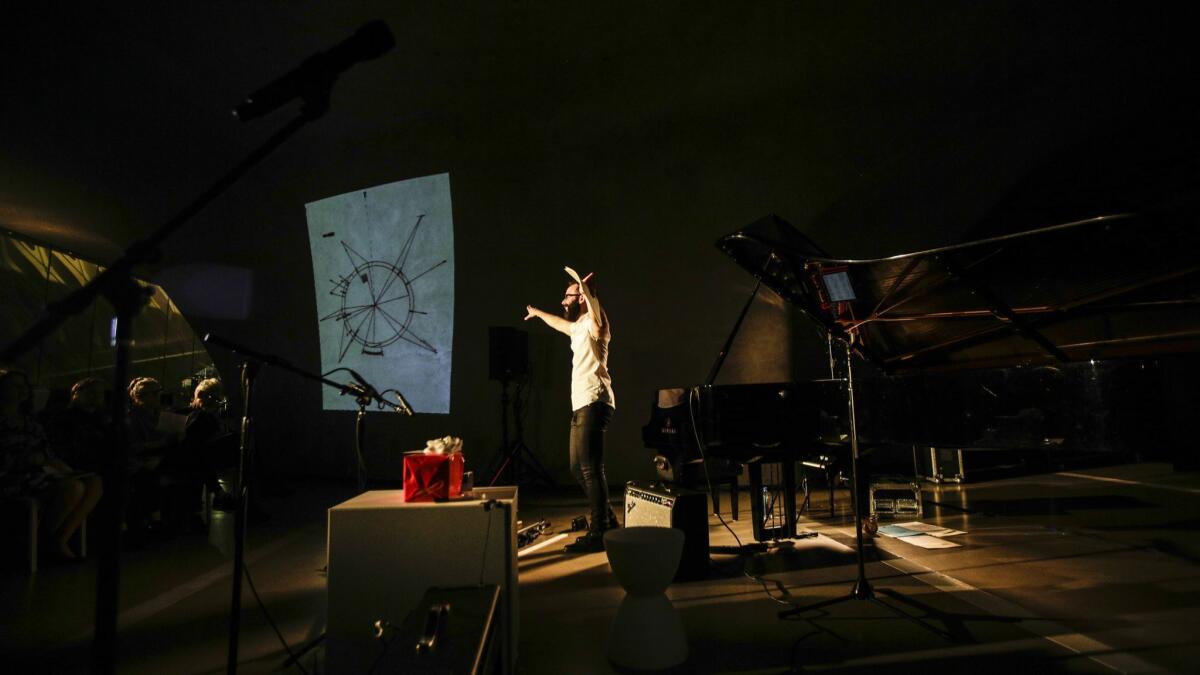Review: At the Broad, exploring Jasper Johns’ connection to music (with an assist from John Cage)

Japan does not automatically come to mind when the subject is Jasper Johns. The artist entered the popular imagination with his paintings of the American flag in 1950s, and he will never cease to be identified with them.
When the Broad museum opened its sublime Johns retrospective, “Something Resembling Truth,” last month, the museum performed a momentary face job on the building’s pockmarked skin with a giant projection of one of the artist’s flag painting, its surface transformed into a canvas-like fleshy texture that seemed like a patriotic act of American can-do.
It was, of course, something only resembling the truth. Where the essence lies in Johns is that what you see is what you get, yet these are not necessarily the same thing. That makes him not only our greatest artist but also our most mysterious.
Japan comes to mind, after all, and it came to mind front and center Wednesday night in the second of pianist Adam Tendler’s three programs at the Broad examining Johns’ relationship to music. The series, which concludes on April 18, is called “Cross-Hatched,” after another series of iconic Johns images. This concert, though, was “Usuyuki: Johns in Japan.”
What does come to mind automatically when Johns and music are in the same breath is John Cage, a composer Tendler has specialized in. He is the first to my knowledge to play Cage’s “Sonatas and Interludes” for prepared piano from memory. Wednesday’s program was Cage-centric, in that it began and ended with Cage works related to Japan or to Jap, as the composer called his close friend. In between were striking pieces by Japanese composers with whom Johns came into contact with or heard performed during a residency in Tokyo, which he visited with Cage, in 1963 and 1964.
At the time, the Japanese avant-garde was in what came to be known as “Cage shock.” We can’t know what Johns exactly encountered at Japanese performances because much of the music Tendler uncovered requires the performer to assemble each work anew for each outing, often with vague instructions harder to follow than anything from Ikea. Cage was the source for this as well.
Toru Takemitsu, Japan’s most famous composer (though not yet at that time), is known for both his voluptuousness and his precision. But in “Corona,” the pianist has only a graphic score (which slightly resembled the logo of the Yamaha piano he played) from which to figure cagey ways of exploring vibration, intonation, articulation, expression and conversion. Each has a color associated with it, and appropriate lighting was projected on the walls of the lobby in front of the Johns exhibition, where the concert took place. For the “conversation,” Tendler placed an old cassette Walkman with distorted recordings of Japanese speech on the piano strings.
The keys were struck from afar by long objects such as a yardstick, umbrella, fishing rod, rake, squeegee and a broom.
The composer and pianist Toshi Ichiyanagi and his wife at the time, Yoko Ono, had come under Cage’s spell in New York in the late 1950s, and they hosted Cage in Japan in 1964. While Tendler spent much of the concert exploring inventive ways to attack the piano, its keys and its strings in Ichiyanagi’s Music of Piano 3 and 4, he made his Japanese piano sound like its legs were nowhere near the ground.
In Ono’s “Lighting Piece,” he held a lighted cigarette light above the strings, like an offering. In her “Wall Piece for Orchestra to Yoko Ono,” he repeatedly banged his head against the side of the nearby escalator. For Takehisa Kosugi’s “Distance for Piano,” the keys were struck from afar by long objects such as a yardstick, umbrella, fishing rod, rake, squeegee and a broom just like the kind Johns liked to paint.
In 1964, around the time of Cage’s trip to Japan, he wrote “0’00” “ with the instruction to amplify the performance of any dedicated action (one he used to catch on his correspondence while also performing); Tendler opened the program by using it to wrap a wedding gift.
The tiny “Haiku” pieces consist of alluring pings gone before you can quite grasp them. “Electronic Music for Piano,” a 1964 work very much in the Japanese spirit, is a set of enigmatic instructions for manipulating sound and silence. Tendler offered a focused six-minute study in sonority and its absence. A new recording released last week by pianist Tania Chen and Sonic Youth guitarist Thurston Moore goes on for a fascinatingly contentious 70 minutes.
Tendler ended with Cage’s “Cheap Imitation,” a rewriting of Satie’s opera “Socrate” to accompany a dance by Merce Cunningham for which Johns designed the costumes. In a seemingly impossible feat, Tendler memorized the meandering half-hour score and played it with entrancing musicality, if perhaps less plainness than Cage imagined.
Ghostly video of the Cunningham company from 2011 played on the walls. But it was Tendler’s sensuous solemnity that best encompassed a Japanese sensibility (although Asia had nothing to do with it), the careful luminosity of Johns painting and, somehow, the sense that hitting a piano with a broom and your head against the wall is a proper prelude to playing the keys with utmost sensitivity.
I was put off by Tendler’s overly romanticizing “Sonatas and Interludes” during the 2012 Cage centennial. He’s grown into a remarkable and insightful musician.
ALSO
Frank Gehry tapped to design Colburn concert hall
Joffrey Ballet dazzles in L.A. Opera’s ‘Orpheus and Eurydice’
Has MOCA’s firing of the chief curator triggered a museum identity crisis?
Taylor Mac on gay history, ‘Hamilton’ and his 24-hour L.A. extravaganza
More to Read
The biggest entertainment stories
Get our big stories about Hollywood, film, television, music, arts, culture and more right in your inbox as soon as they publish.
You may occasionally receive promotional content from the Los Angeles Times.











